This is a summary of the book Value Proposition Design by Alexander Osterwalder, Alan Smith, Yves Pigneur, Greg Bernarda & Trish Papadakos.
Do you find that you:
- Get frustrated with unproductive meetings and misaligned teams?
- Find it difficult to create real value in your product or service?
- Get involved in hip projects that ultimately turn out to be nothing?
- Get disappointed by the failure of a good idea?
In this article, you’ll learn how to create value for your customers, bring out the best in your team, and how to work on an idea without wasting time.
Let’s start…
Value Proposition Canvas
The Value Proposition Canvas is used to look at who your customer is, what they want to achieve and how your product will help them achieve this:
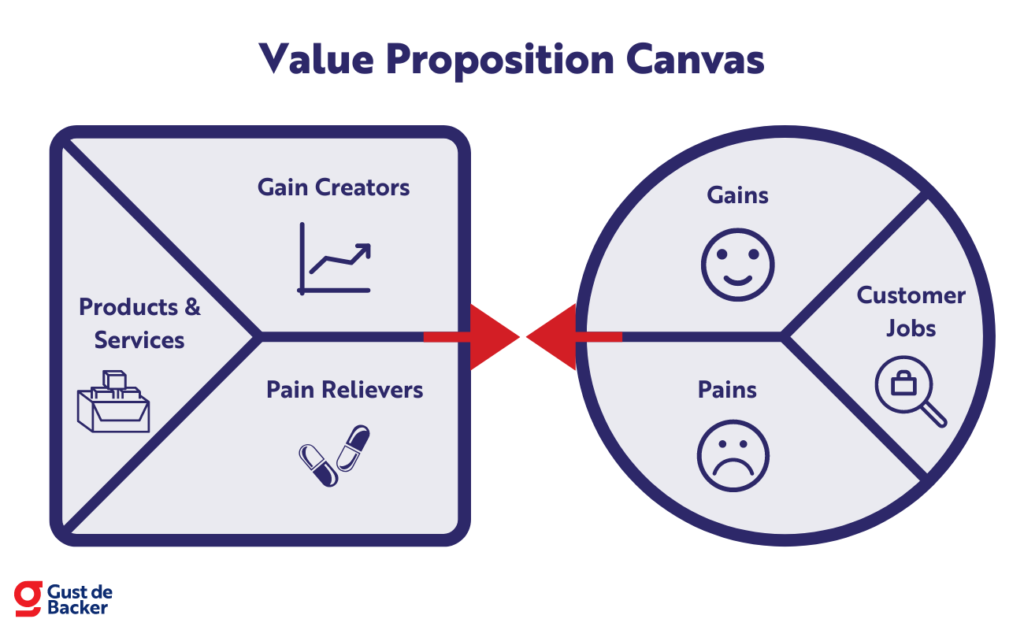
Don’t feel like reading? This video gives a brief explanation:
We start with the customer…
1. Customer Profile
The Customer (Segment) Profile describes a specific customer segment in your business model, this is broken down into:
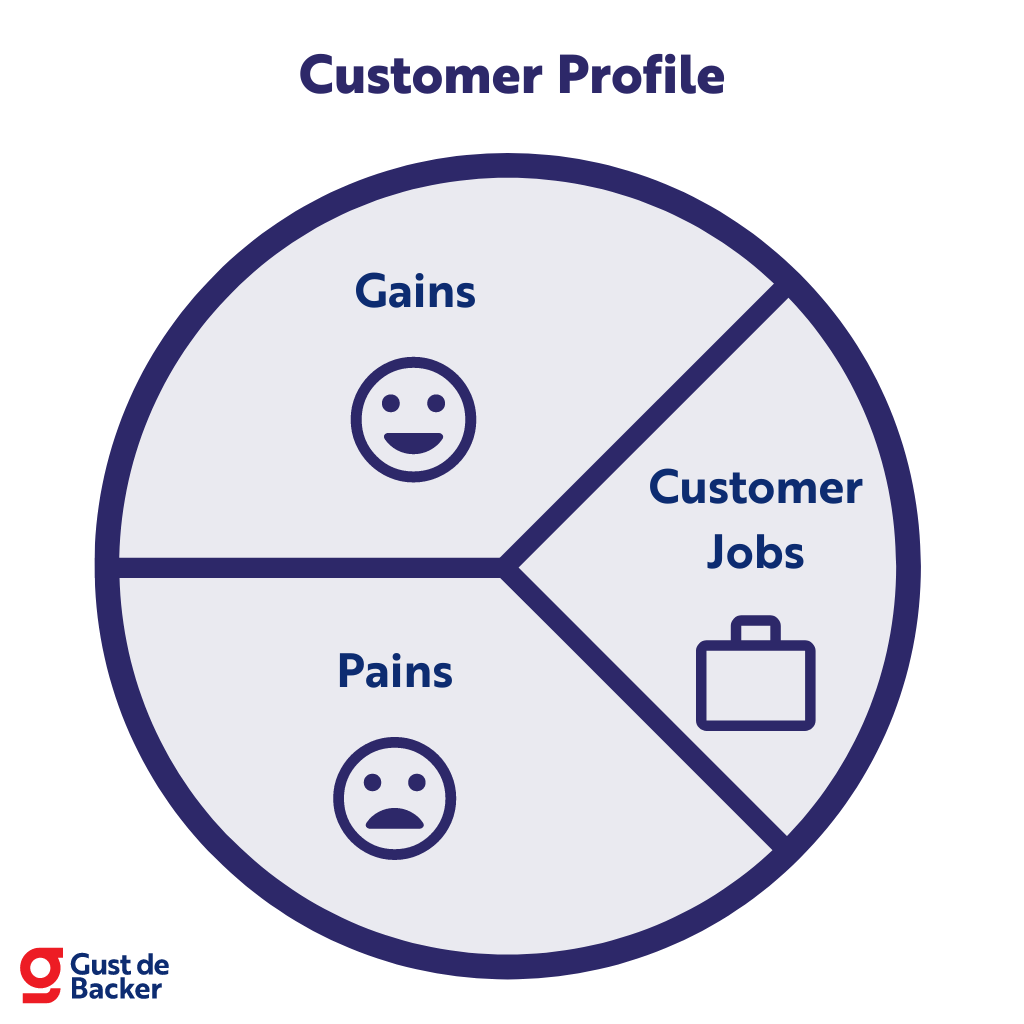
- Jobs: what your client is trying to accomplish (‘getting the job done’).
- Pains: describes bad outcomes, risks and obstacles for your customer in getting a ‘job done’.
- Gains: the outcome of what your customer is trying to achieve in concrete benefits.
1.1 Customer Jobs
A ‘Customer Job’ is something your customer is trying to achieve in work or in his life, Jobs are divided into:
- Functional Jobs: the customer is trying to find a solution to a specific problem, such as an air conditioner for the heat, a washing machine for the laundry or a heater for the cold.
- Social Jobs: the customer wants more status or prestige, such as buying branded clothing or purchasing a luxury car.
- Personal/Emotional Jobs: the customer is looking for a certain feeling, such as the feeling of security, joy or safety.
- Supporting Jobs: this helps the customer accomplish a task, such as comparing different products.
It is important to make sure that the different Customer Jobs are broken down by degree of how important they are to the customer.
1.2 Customer Pains
The ‘Customer Pains’ describe what gets in the way of your customer before, during and after getting a ‘Job done’:
- Undesired outcomes, problems and characteristics: functional pains, such as that the solution doesn’t work, that the customer’s status is down or it’s not fun to do.
- Obstacles: things that stop the customer from getting their ‘job done’, such as lack of time or the price of a solution.
- Risks (undesired potential outcomes): what can go wrong, such as losing prestige or getting fired.
Also with the Customer Pains, it is important to subdivide them according to how important they are to the customer.
It is helpful to know exactly how extreme the pain is. The customer may indicate that she does not want to wait for a solution, but then it is up to you to find out the maximum amount of time the customer is willing to wait.
1.3 Customer Gains
With the Customer Gains the outcome and end result is described, these can be divided into 4 different types:
- Required Gains: without this type of gains the solution you offer will not work, a washing machine needs to get your clothes clean.
- Expected Gains: this type of gains is what the customer expects at the very least, even if the solution works without them. For example, a washing machine must be able to run different programs.
- Desired Gains: these are the gains that customers would like and which they could think of themselves. Think for example of the installation of the washing machine in the house.
- Unexpected Gains: these are the gains that go beyond the expectations of the customer, customers would not initially think of. Like not needing detergent in a washing machine.
The gains should also be as concrete as possible, try to express them in numbers. In addition, it is also important to subdivide the gains according to how important they are to the customer.
Common mistakes
The Value Proposition Canvas is not the easiest model to fill out, therefore some common mistakes in the Customer Profile:
- Different customer segments in one profile: create a different Value Proposition Canvas for each type of customer.
- Merge Jobs and Outcomes: jobs are the tasks that a customer tries to achieve and gains are the end results.
- Only focus on functional jobs: obtaining status with a product can be more important than finding the right practical solution.
- Start with a certain bias: you should not be in your head with the solution you want to offer, but go in blank.
- Finding too few jobs, pains and gains: it is important to write down as much as possible and then prioritize it.
- Too vague descriptions: the jobs, pains and gains should be as concrete and clear as possible.
Keep asking as often as possible why your customer gives a certain answer.
Example
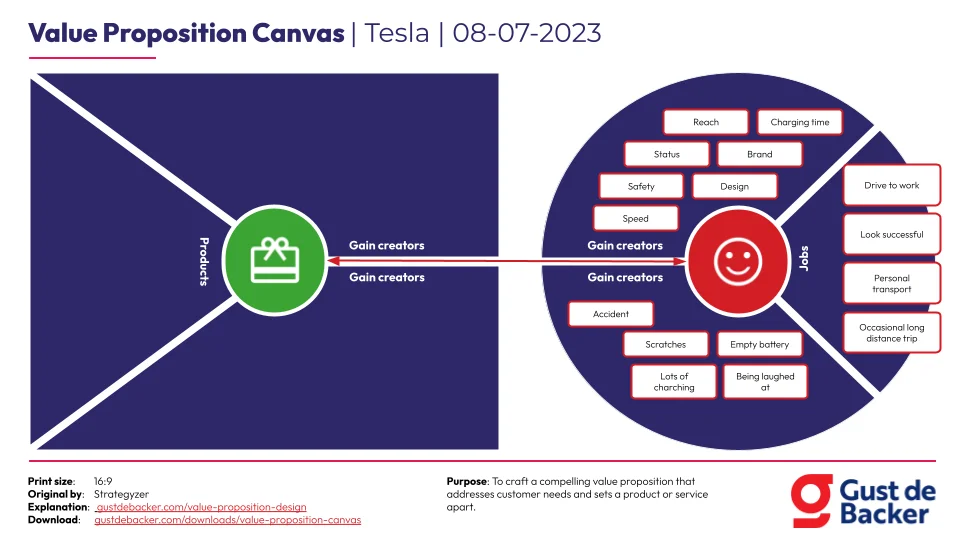
2. Value Map
In the Value Map, you’re going to describe exactly what you offer and how it helps the customer with their ‘Job to be done’:

2.1 Product and Services
This is a listing of everything you offer to the customer, everything the customer might find in your store. There are 4 types of products and services:
- Physical/tangible: physical products.
- Intangible: copyrights or services.
- Digital: music, SaaS or perhaps a platform.
- Financial: such as investments or insurance.
It is important to subdivide your Products and Services based on how important they are to the customer.
2.2 Pain Relievers
The Pain Relievers describe how your product or service is going to take away the customer pain…
It is not necessary to have a specific pain reliever for every pain, but the most important pains should be taken away.
As with all the previous components, it is important to subdivide them based on how important they are to the customer.
2.3 Gain Creators
The Gain Creators describe how your product or service will ensure that the Customer Gains are achieved…
Again, the Gain Creators don’t have to achieve every gain, but they do have to achieve the most important gains.
Make a subdivision based on how important it is to the customer.
Common mistakes
Some common mistakes to watch out for:
- Writing down all your products and services: make sure you only write down the products and services that apply to that specific customer segment.
- Adding products and services to the pain reliever and gain creator fields: the pain relievers and gain creators offer explanations and can be properties of your products and services.
- Offer pain relievers and gain creators that don’t match the pains and gains: the pain relievers and gain creators must match the pains and gains of customer jobs.
- Want to address all pains and gains: it is really not necessary to address all pains and gains in your gain creators and pain relievers.
Example
Download the Value Proposition Canvas:
See an example:
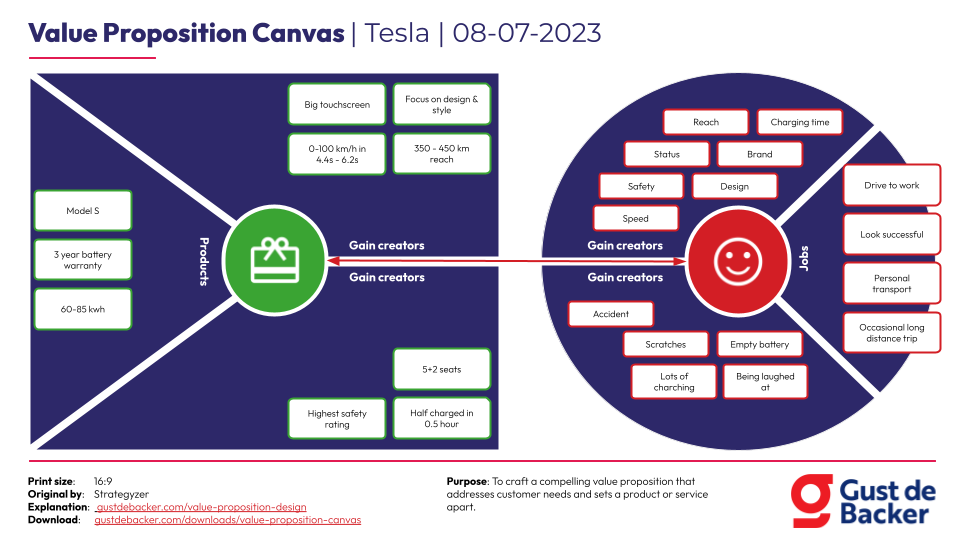
3. Fit
You achieve a fit between your customer profile and the value map when your customer is (almost) ready with his wallet after hearing your value proposition…

There are 3 types of fits:
- Problem-Solution Fit: you have evidence that you have the right jobs, pains and gains and your value proposition aligns with them.
- Product-Market Fit: you have evidence that your products, services, pain relievers and gain creators have traction in the market.
- Business Model Fit: you have proof that your value proposition can be poured into a scalable and profitable business model.
Here, especially in B2B, it is important to include the entire Decision-Making Unit.
10 characteristics of a good Value Proposition
There are several characteristics that a good value proposition meets:
- Fits into a business model.
- Is focused on the most important jobs, pains and gains of the customer.
- Focuses on jobs, pains and gains not (yet) addressed.
- Are not only functional, but also emotional and social.
- Becomes focused on a few jobs, pains and gains, but solves them extremely well.
- Are aligned with how the customer measures success.
- Are different from what the competition is already responding to directly.
- The value proposition is better than the competition in at least one dimension.
- Are focused on jobs, pains and gains that many people have or that people are willing to pay money for.
- Is difficult to copy.
How do you validate the Value Proposition?
Create an Ad-Lib:
Our [Product or Service] helps [Customer Segment] with the [Jobs to be done] by [verb] and [verb]. (+ , but not like [competitive value proposition])
It is hugely important not to waste a lot of time, energy and money building a complete solution. It is better to create a prototype or MVP, where it is important that:
- You look at the market with fresh eyes, rather than already assuming what can’t be done.
- It’s visual and tangible.
- You don’t fall in love with the first ideas.
- Things are not fixed immediately, there needs to be chaos.
- Work in iterations, the first draft is not perfect.
- Ask for lots of feedback from everyone, criticism is good.
- Make sure you fail fast, learn and iterate.
- Enough creativity is applied.
- Use ‘Shrek Models’, extreme prototypes that you will never build, but can have discussions about.
- Keep track of learnings, insights and progress.
Type of market
If you’re entering a market with a niche/unknown product:
- Challenges:
- Low customer awareness
- Lack customers to get messaging guidance from
Brainstorm internally to find a value proposition:
- List your product’s key features
- Pinpoint those that are unique
- List customer pain points for each feature
- Define desirable outcomes for each pain
- Score pains/outcomes by severity & frequency
- Edit top-scored pain/outcomes into UVPs
- Score the UVPs (and go with the best one)
If you’re entering an existing market you can perform voice of customer research.
Techniques for gaining insights
There are 6 techniques that offer you insights into your customer:
- Data Detective: data that is already available, such as reports, Google Trends, search volume, market research.
- Journalist: talk to customers, conduct interviews and look for patterns in them. It is important that you are open, that you listen more than you talk, that you look for facts instead of opinions and that you ask questions to find the actual motivation.
- Anthropologist: in a B2C case, you could spend a day walking with the customer or observing their buying behavior. In B2B, you could work alongside the customer or consultant.
- Impersonator: use your product or service as your customer would.
- Co-creator: get customers to help create your product or service and basically become co-creators.
- Scientist: get customers to participate in an experiment and learn from those outcomes.
To get started with your Value Proposition Canvas, it is useful to look for your earlyvangelists, or people who:
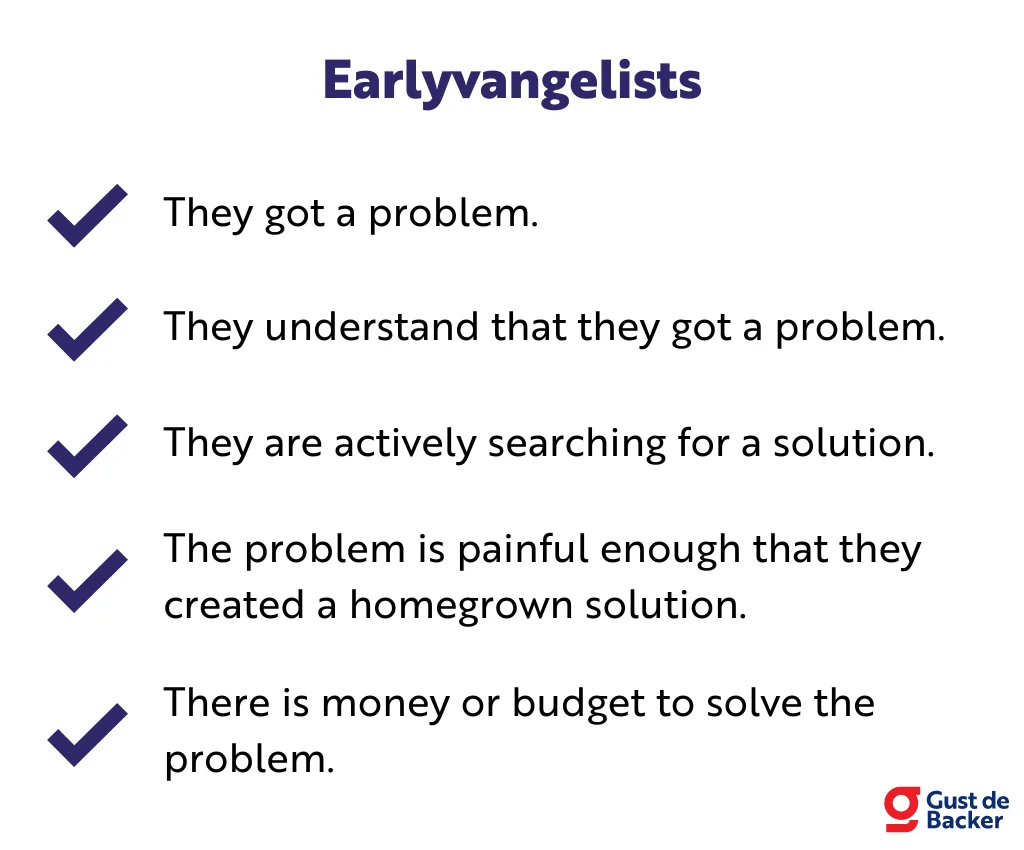
You could gain insight into competitors with the Strategy Canvas:

Presenting Effectively
If you are going to present MVPs, make sure you pay attention to the following points:
| Do’s | Don’ts |
| Simple | Complex |
| Tangible | Abstract |
| Present what is necessary | Present everything you know |
| Customer-centric | Feature-centric |
| Share information piece by piece | Share all information at once |
| Supporting media | No supporting visuals |
| Storyline | Random order of information |
When presenting, it is also important not to pass judgment on the criticism, because then people will not dare to criticize.
If necessary, you can apply Bono’s Thinking Hats principle:
- First you have people wearing a white hat to give feedback, in doing so they are neutral and give objective feedback.
- Then, wearing a black hat, they can give feedback in which difficulties, weaknesses, dangers and risks can be discussed.
- If the risks are clear, a yellow hat is used to give feedback, in which plus points and positive elements are discussed.
- Finally, the green hat is put on in which ideas, alternatives and possibilities are discussed on the problems from the black hat phase.
Dotmocracy
To prioritize different criteria among individuals, you can put red stickers on a multi-criteria table or give them numbers:

Validate, validate, validate….
So, now you can start validating your assumptions.
Now I’m curious, what else do you need to get a Problem-Solution Fit?
Let me know in a comment.
P.S. if you need any additional help, let me know at [email protected]
The 6 components that are highlighted in the Value Proposition Canvas are the customer jobs, customer pains, customer gains, your products & services, pain relievers and the gain creators.
You fill in the Value Proposition Canvas together with people from your company who know the market and the customer. It is important to have sufficient insight into the market and your customer.
A Value Proposition is a promise of value that you deliver to the customer.
The Value Proposition Canvas is used to look at who your customer is, what they want to achieve and how your product will help them achieve this.

![Business-Driven Marketing (BDM): 8 Steps to Drive Business Impact [+14 Templates]](https://gustdebacker.com/wp-content/uploads/2024/07/Business-Driven-Marketing-BDM.png)
![Automate ~30% of Repetitive Marketing Tasks with AI: 5 Easy Steps [+ 7 Expert Prompts]](https://gustdebacker.com/wp-content/uploads/2024/07/AI-in-Marketing.png)
![Customer Journey Map (2025): How-to & Examples [+ Template]](https://gustdebacker.com/wp-content/uploads/2023/11/Customer-Journey-Map.png)
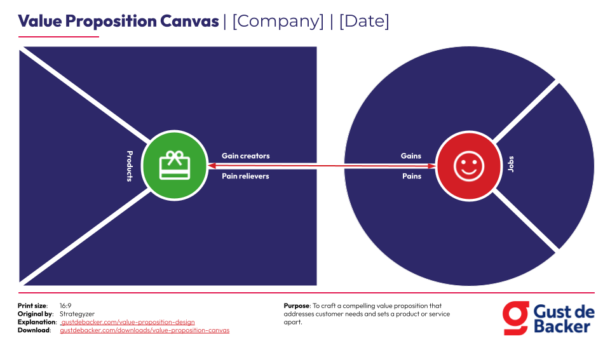
thnak you so much it was worth sharing, making my journy path more clear.
Thank you, Mehdi!
Great content and advice – well presented and very useful for someone like me who is developing an MPV.
Will be using this formula to create my Lean Model Canvas and Value proposition – Thanks
Thank you, Phil!
Very nice
Great to hear!
Hellow your work is too nice has strong points and easy which person can be able to read and understand in simple way
Thank you Paulina!
Thank you!!! this information is so good! I will share it with some students!
Great to hear! If there are any questions, please feel free to reach out.